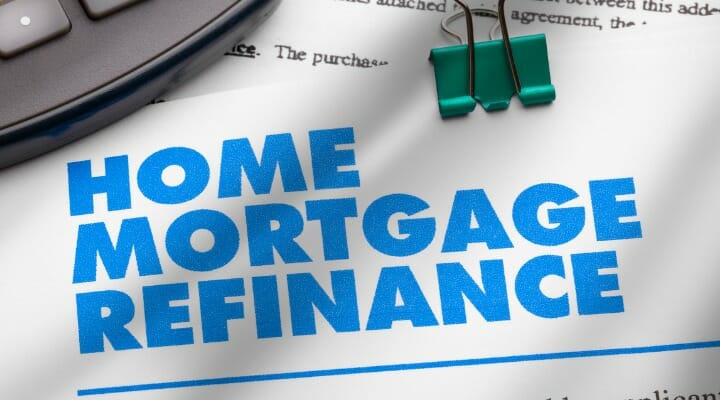What Is Refinancing A Mortgage

Are you stuck in a financial rut? Refinancing your mortgage may be the answer to getting out of it. Refinancing is an opportunity to restructure your home loan, and it can help reduce your monthly payments or lower the interest rate. It can also help build equity faster because more of each payment goes toward principal rather than interest. In this article, we’ll cover what refinancing is, types of refinancing, requirements for qualifying for a mortgage refinance, and the process of refinancing a mortgage loan.
What Is Refinancing?
Refinancing your mortgage can be a great way to save money and improve your finances over time. Refinancing is the process of taking out a new loan to pay off an existing loan, usually, to reduce interest rates or monthly payments. It can also be used to access cash from the equity you’ve built up in your home. When you refinance, you’ll need to consider factors such as closing costs, loan terms, credit score, and cash-out refinance options. There are two main types of refinancing: adjustable-rate mortgages (ARMs) and fixed-rate loans. ARMs start with lower interest rates that adjust over time, while fixed-rate loans offer more stability with consistent monthly payments throughout the life of the loan. It’s important to compare different lenders and their respective mortgage rates before deciding on a refinance option. Also, be sure to factor in private mortgage insurance requirements for conventional loans and other additional costs associated with refinancing so you can maximize your savings.
Refinancing can be a great way to save money and improve your financial situation in the long run. With all of the options available, it’s important to do research and compare different lenders before committing to a refinance loan. Now that you have a basic understanding of refinancing, let’s take a look at some of the different types of refinancing that are available.

Requirements for Qualifying for a Mortgage Refinance
Refinansiere Boliglån can be a great way to save money, but it isn’t right for everyone. Before you start the process of refinancing your loan, it’s important to make sure you meet the requirements and that the refinance will benefit you in the long run. To qualify for most types of mortgage refinances, you typically need to have a good credit score, stable employment history, and enough equity in your home. You also need to be current on all payments associated with your current loan, including taxes and insurance. Additionally, some lenders may require proof of income or an appraisal of your home before approving a refinance loan. Once you have met these basic requirements and determined that refinancing is right for you, it’s time to shop around for lenders who offer competitive rates and terms. Comparing different offers can help ensure you get the best deal possible on your new loan.
Refinancing your mortgage can be a great way to save money, so don’t miss out on the opportunity! Next, we’ll take a closer look at how your credit score and history play an important role in the refinancing process.
Credit Score and History
Your credit score and history are important factors when it comes to refinancing your mortgage. Your credit score will be one of the major factors a lender looks at when deciding whether or not to approve you for a loan. Generally, lenders prefer borrowers with higher credit scores, as they tend to be less risky borrowers. If you have a good credit score, you may be able to qualify for lower interest rates and better terms on your refinance loan. On the other hand, if your credit score is lower than average, you may be charged higher interest rates or even denied entirely.
In addition to the numerical aspect of your credit score, lenders may also take into account payment history and other information from your credit reports. Paying bills on time is an important factor in determining whether or not you’ll be approved for a refinance loan. It’s also important that you look over your reports before applying for a mortgage refinance so that you can correct any inaccuracies that could affect your ability to get approved for a loan.
Income Verification
Income verification is an important step in the mortgage refinance process. Before a lender grants you a loan, they must verify that your income meets the requirements for repayment. The type of verification will depend on your circumstances and the type of loan you’re applying for. For example, if you’re self-employed, lenders may require copies of your tax returns or bank statements to prove that you have steady income coming in. If you’re employed by someone else, lenders may ask for recent pay stubs or other proof of income. In addition to verifying your income level, lenders may also consider how long you’ve been employed at your current job when determining whether or not to approve your loan application. Keep in mind that lenders are looking for stability when it comes to employment and income – so make sure that you can provide them with evidence of long-term employment and consistent payments over time.
Equity in Home
Equity in your home is the difference between what you owe on your mortgage and the current market value of your home. It’s essentially the amount of ownership you have in your house. As you make payments toward your loan, the equity in your home increases. You can also increase the equity in your home by making improvements or upgrades that increase its value. In addition, you may be able to access some of the equity in your home through a cash-out refinance or an equity loan. With a cash-out refinance, you replace your current loan with a new one for more than what you currently owe and use some of the proceeds to pay off existing debt. An equity loan uses some of that equity as collateral for a new loan, allowing you to borrow against it for other expenses. Both options can provide additional funds for investments or major purchases, but it’s important to consider the risks involved before taking out either type of loan.

The Process of Refinancing a Mortgage Loan
Refinancing a mortgage loan is a great way to save money and shorten the length of your loan. Before you refinance, it’s important to understand the process and calculate the costs involved.
The first step in the refinancing process is determining how much equity you have in your home. This is the difference between what you owe on your mortgage and its current market value. Once you know this amount, it’s time to shop for a new loan. Your credit score will play an important role in determining what type of loan you qualify for, so make sure to check your credit reports before applying. You can choose between a fixed-rate or adjustable-rate mortgage, depending on your situation and needs.
Once you’ve chosen a lender and loan type, you’ll need to consider potential closing costs and monthly payments. Refinancing often requires paying upfront fees such as appraisal costs or private mortgage insurance premiums, but these may be rolled into the new loan if desired. Additionally, switching from a longer-term loan to a shorter term typically results in higher monthly payments but more savings in interest over time.
By doing research and crunching numbers ahead of time, refinancing can be an effective way to save money on your mortgage payments each month—and build equity faster!
Refinancing your mortgage loan can be a great way to save money and build equity faster. With careful research and consideration, you can make the right decisions for your situation. Now that you know the basics of refinancing, it’s time to select a lender and loan type – but where do you start?
Selecting a Lender and Loan Type
Selecting a lender and loan type for your refinancing can be daunting. It’s important to shop around and compare your options to make sure you get the best deal. Some lenders offer conventional loans with fixed-rate mortgages, while others offer adjustable-rate mortgages. Depending on your credit score, you may be eligible for lower rates or other incentives such as cash-back rewards or no closing costs. Many lenders also provide online tools to help you compare rates and calculate monthly payments.
When selecting a lender, it’s important to read customer reviews and check their Better Business Bureau rating. You should also take into account any fees they may charge, such as origination fees or closing costs. Finally, make sure to ask about any prepayment penalties if you plan to pay off the loan early. With careful research and consideration, you can make an informed decision that will save you money in the long run.
Applying for the Loan and Gather Documentation Lock in Your Rate and Close on the Loan
Once you have chosen a lender, it’s time to apply for the loan. You will need to provide your income, employment, and asset information, as well as any other documents required by the lender. This includes copies of recent tax returns and bank statements. The lender will also review your credit score and history before making their decision.
Once you are approved for a loan, you should lock in your rate to protect yourself from fluctuations in the market. After that, it’s time to sign all of the paperwork and close on the loan. Before closing, make sure to double-check that all of the documentation is correct and ask any questions you may have about the process or terms of the loan agreement. By taking these steps at each stage of refinancing your mortgage, you can ensure that everything runs smoothly and get the best deal possible.
Conclusion
At the end of the refinancing process, you will have a new loan with a lower interest rate and improved terms. Depending on your situation, this could mean more savings each month or increased cash flow. Before committing to a loan, make sure to consider all of the factors involved in refinancing and shop around for competitive rates. This will help you get the best deal possible on your new mortgage. Refinancing can be an excellent way to save money and improve your financial situation, so take the time to explore your options and make an informed decision.




